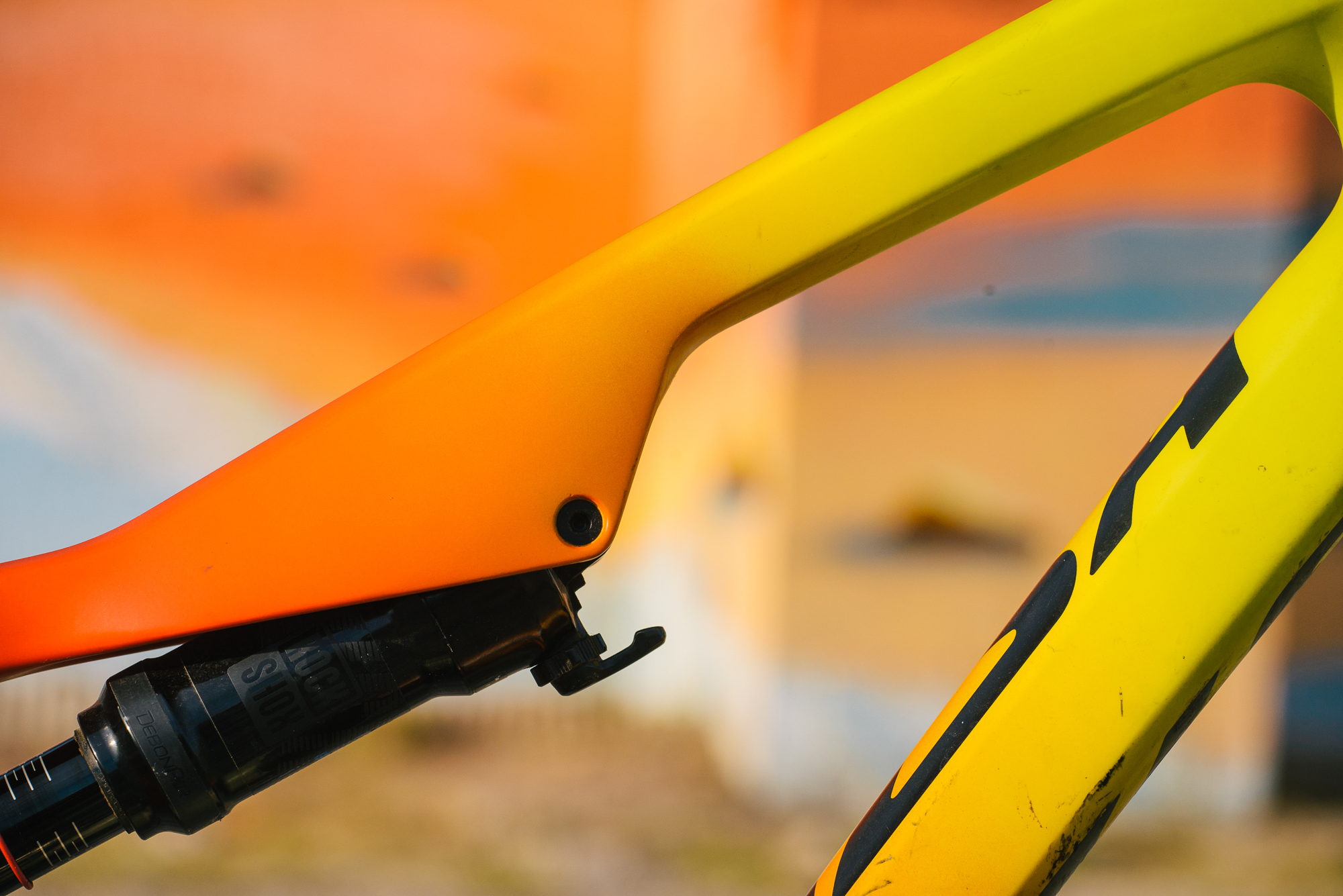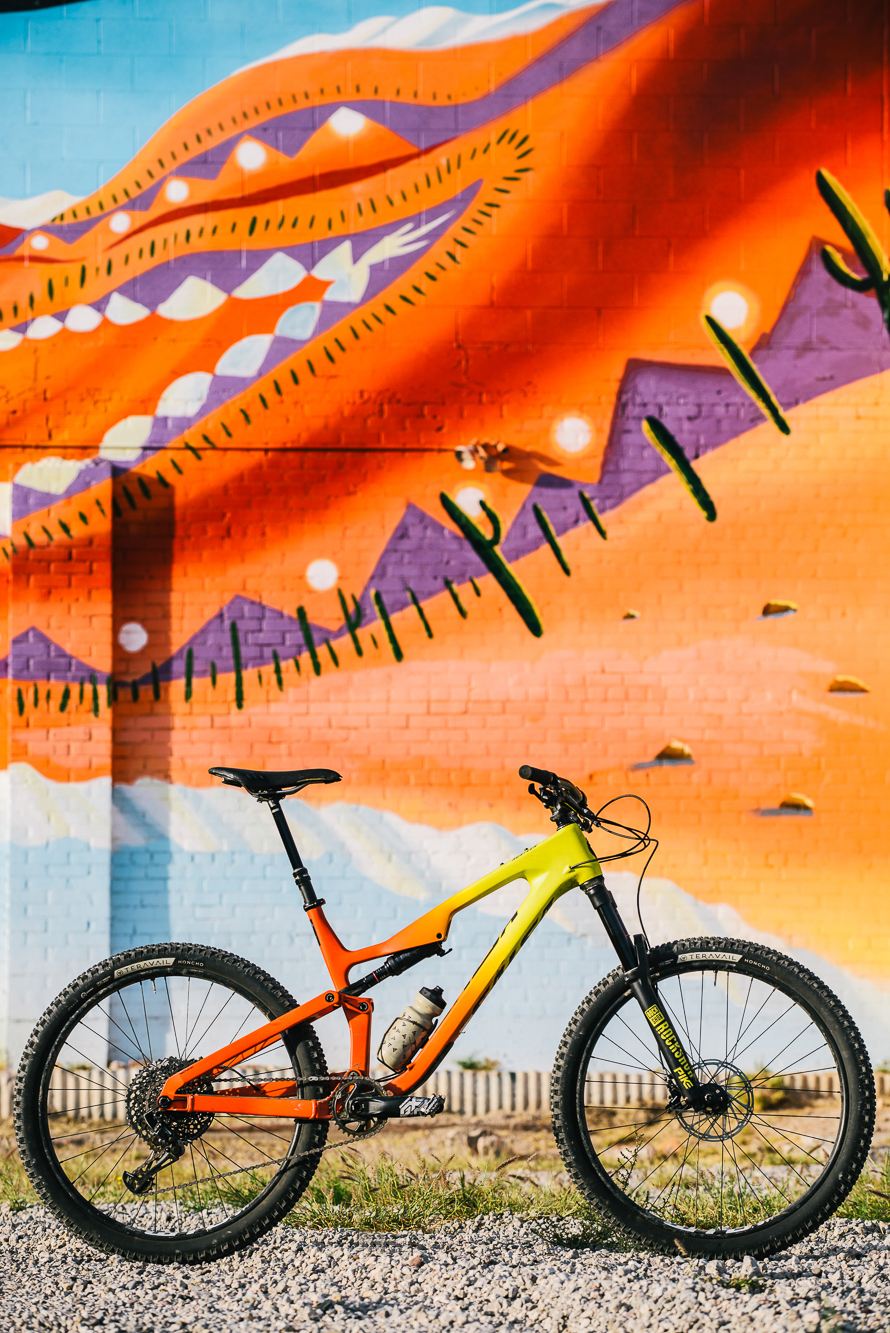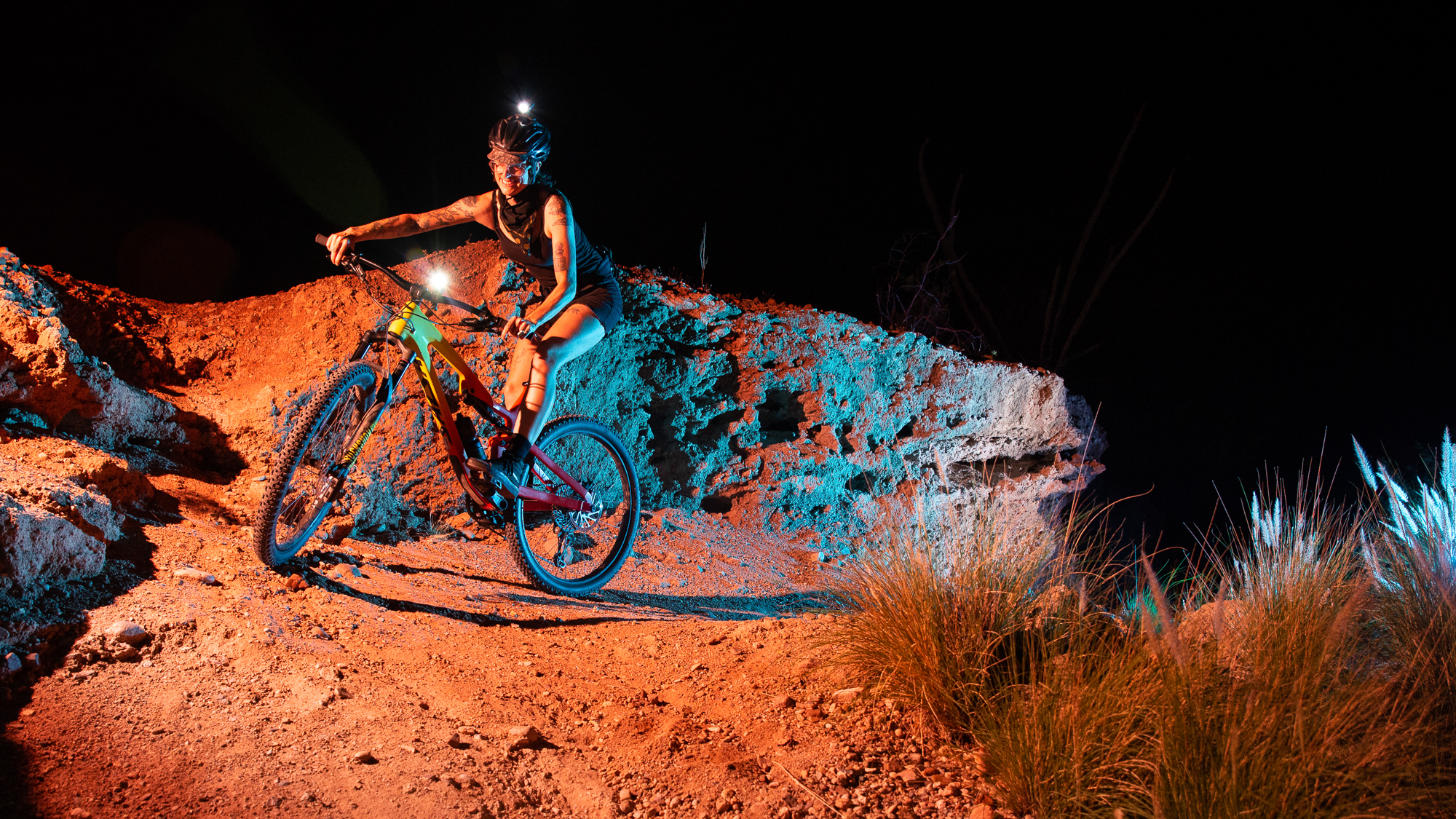Alrighty, y’all today we are talking about the Rustler from Salsa Cycles, their new “ultimate trail bike” with 130mm of split pivot rear travel and a 150mm Rock Shox Pike taking care of business out front. Now that’s about enough for numbers for awhile, I ain’t no nerd talking about leverage ratios at an Interbike booth ok? We’re gonna talk about feelings today; how was your ride yesterday? How are you doing today, like actually? Go ahead, tell me what’s good below.
Anywho, feelings, it’s easy to get wrapped up in the number crunching and deciphering the perfect bike down to a tenth of a degree of a seat tube angle these days, but what if we talked about how a bike made us feel? In the end, these reviews are all just my feelings so let’s leave out all the B.S. I’m gonna tell you how I felt about this rad bike, Monique is gonna tell you what they think, and then I’ll take some questions from the great ether of Instagram.

About a year ago, I had just ridden a portion of the Lemmon Drop, a ride north of Tucson. It’s a massive, chunky, rocky, ride down the Catalina Mountains. I was riding my hardtail 29er, which I found to be capable, but my elbow aching with tendinitis had some different opinions. The riding is very technical and requires some serious navigational prowess on a hardtail. The bike could ride almost everything, but, I was thinking, what if my sweet shreddy hardtail had just a little suspension out back? I could use a little squish in the back, just to lessen the fear of airing things instead of crawling through the chundery rock gardens. The few longer travel bikes I had ridden with symmetrical suspension travel felt like way too much travel in the rear and rode puggy. Coming from riding rigid or hardtail bikes most of my time on a mountain bike I wasn’t interested in some mega plush magic carpet ride. When our local Salsa rep sang me a song about a new trail bike with asymmetrical suspension, it sounded almost exactly like what I was seeing in my mind’s eye. A few weeks later I saw a photo of that hot yellow/orange/red fade paint job and I was smitten.
When the box arrived and I had ripped all the packaging off and glimpsed that sweet fade for the first time I was so stoked to get it rolling around. Can we talk about that paint job for a second? That sweet fade, while far from being original, looks gorgeous. I’d personally rather be riding a blazing desert sunset down the trail instead of some wannabe batmobile. The internal routing, which may be a mechanical headache, nonetheless keeps the lines and shapes of this frame clean, they hit the nail on the head with this one. Straight out of the box the paint job brightens my day and I haven’t even thrown a leg over this thing yet. While paint is all cool n’ stuff, that paint job comes with the higher end GX build which is $1000 more than the NX eagle/ Revelation fork spec’d build. The NX build is a more subdued black to aqua fade and the frame only option is just straight black. I’m not a big fan of the price point/build kit deciding which paint job you get, it seems to be a thing at Salsa and surprise surprise the most expensive build always has the coolest paint.

The best way I can describe this bike is that it is like a good friend; supportive and confidence-inspiring. Firstly, supportive, the suspension is supple yet supportive like the aforementioned good friend, pushing your butt up and over a fence for an evening of light trespassing. The newly redesigned Split Pivot suspension is instantly a palpable upgrade from my previous time on a past iteration Salsa Redpoint. I can’t believe how supportive and solid the rear end feels even with the shock totally open. On roads, I never needed to do more than flip the switch to the trail setting. While climbing on the trail the shock would bob with trail input and after absorbing that bump it would return right back to being supportive, never skipping a beat or bouncing excessively. On the whole, I found the Rustler turned me into more of a seated climber than I normally would have been simply by how well the Split Pivot system handled. The slacker-than-a-track bike seat tube angle that seems to have fallen out of favor was the only caveat to the superior climbing ability of this steed. While I love the feeling of a slack seat tube and doing wheelies, it did make keeping the front wheel on the ground while climbing a bit harder, but shut up and get rad and wheelie up that rock garden ya nerd. Secondly, confidence-inspiring; what good is a friend helping you hop a fence if you’re not sure if they’re gonna abandon you as soon as the cops show up, gotta have confidence. Sure, I was feeling amazing riding uphill on this bike, but the flip-side is when the party really starts. The redesigned suspension leverage ratio makes that 130mm of rear travel go a long way and begs you to try and bottom it out. The front end geometry of this bike won’t shock anyone unless you are still riding an El Mariachi and think a 71-degree headtube is a-ok. The rustler runs about a degree slacker and has 10mm more travel in the fork than my hardtail and I loved it. The riding out here in Tucson warrants a lot of crawling through techy rock gardens, so having your front wheel as far out in front as possible is preferable. When I finally got to take this party machine back up to the trails on Mt Lemmon, I was instantly flying down double my normal pace on the trails. Confidence; inspired. Tire sidewalls: shredded on the third turn. The glee of riding a proper full-suspension bike on a trail that fully warrants such a bike is giggle and whoooop inspiring at the least. All those jibby lines and rock drops I had been eyeing for months finally became a reality where the possibility of casing my hardtail had me saying “naaaah, not worth it” previously. Rock gardens only yielding a single line on my hardtail suddenly became a plethora of options. Riding all of these trails with such speed and confidence had me shuddering at the prospect of riding a longer travel bike, I ain’t trying to break some bones. This bike inspires you to ride it like it is a much longer travel bike while still having the fun characteristics of a smaller more flickable bike. I felt like I could ride this bike the way I always imagined myself in my mind’s eye. This bike is fun, it parties, it’s a damn good wingman at the shreddy trail party: supportive and confidence-inspiring.

So the bike rides good, but what about all that other hoopla bolted to the frame? The build is a quality mid-range package; the brakes stop real good and the gears shift great, crazy right? The cockpit is nicely adorned with a set of Salsa’s rustler bars which have a more than subtle back sweep and generous width, creating a comfortable front end. I run a set of them on my hardtail. It would have been cool to see the carbon version on this higher-end build, but that’s above my pay grade anyway. The Reverb dropper has one of the most solid lever actions of any droppers I’ve tried, but the amount of force needed to drop the seat was more than I would have liked and that action got sticky occasionally. The GX Eagle drivetrain worked flawlessly throughout my time with the bike.
So what did/would I change on this bike? I swapped the stock WTB saddle for something that fits me a little better. Also, I prefer the feel and serviceability of Shimano’s hydro brakes, so I would personally prefer them to the Sram brakes that came on the bike. The stock build was spec’d with Maxxis DHF/DHR which are great tires for trails with softer soil, but the desert is another beast. The tires worked great for the higher elevation trails near Tucson, but I wound up with a large sidewall tear quickly and found the widely spaced knobs squirrely on the more hardpack trails around town. I swapped them out for a pair of Teravail Honcho 2.4s. While the frame can accommodate up to a 27.5 x 2.8 tire, I wanted to see how the bike handled with a slightly smaller tire combo, a first in the history of me riding bikes. The bike felt much quicker and more nimble without the lumbering DH tires and the tighter spaced knobs left me feeling more confident on our loose-over-hard trails here. If I lived anywhere besides the desert, which requires the toughest tires/sidewalls, I could see this being a very fun bike with supple 2.8” slippers laced up. As this bike is not designed to work with multiple wheel sizes, tires are going to be the most important part of the build I’d say. If you want to run narrower tires, go for it and switch the flip chip to raise the bottom bracket a little, or put some big fat plushies on it and drop the bb back down. Being able to fine-tune the geometry and have such a wide range of options for tire sizing is a big advantage of this bike’s platform.

So, in the end, was this my dreamy progressive hardtail with some rear suspension aka full sqush dreamboat? Hell yeah! This bike parties, It begs to hit those kickers, and gap over those roots and rock gardens. Will this bike replace your enduro rig? probably not. My opinion is that this is a great bike to upgrade to when you have maxed out what is possible with your current rig and want that next level of confidence and capability. Maybe you have a 27.5+ hardtail and you want to snag a frame and fork and switch all your parts over instead of a whole new rig, the Rustler can fill that niche. The Rustler is playful, the redesigned Split Pivot suspension is amazingly orchestrated but has limits, nonetheless, I found it capable beyond what the numbers would imply. This bike isn’t what I’d call a quiver killer, it still felt a little hulky for cross country trails (narrower tires helped this) and small for trails with some bigger features. With an experienced person at the helm, this bike is still very shreddable and at the same time able to inspire confidence in less experienced riders who won’t be looking for a big hit bike. If you fall somewhere between XC and DH and you want to party and can pony up the funds (*drum phil*) the Rustler fills a sweet lil spot.
And if you won’t take it from me here is Monique with her thoughts on the rustler:
“It’s a bird. It’s a plane. It’s a Rustler. A two-wheeled dirt hustler. A capable MTBeast that had me feeling all sorts of confident as I descended the switch-back laden singletrack on Mt Lemmon and the loose rutted Starr Pass trails, in west Tucson.

Full suspension bikes always seemed bulky for my petite frame and unnecessary to me unless riding downhill trails (which I seldom shred). While that’s still partially true, there are benefits I never considered like my wrists and body being less fatigued at the end of a ride; or feeling like a majestic wizard upon this neon dragon, at ease in flight on its squared carbon shell. Stable. Steady. Swift.
While my current bike collection does not YET include a double squish bike, I loved comparing how much more I pushed myself in new technical sections and rode familiar sections like a speedy-pants. After my transition from rigid 27.5” mountain bikes to front suspension, my skills and confidence increased immensely and I can only predict the same from a hardtail to full suspension. Sweet sweet supple savory suspension. Once you pop, the fun don’t stop.”
Now some questions from the internet:
Does it change color when yer on acid?
Colors don’t change but man, do they look cooler.
A comment about how the bike industry should have skipped over Superboost…
Hi Sam,
Boost 148 does now seem like an unnecessarily incremental shift when seen with the older 155mm standard that would have made more sense to evolve to originally, but that wouldn’t make people buy as many new wheelsets. Superboost makes more sense to me, but I’m no engineer, so I can see why Salsa would have specced that on their other two models due to the purpose of having massive clearance on multiple size wheel-sets. As this bike isn’t meant for changing wheel sizes, using the more standard-at-the-moment 148mm boost makes sense for now which could also make a simpler of transferring parts and wheels that people already have to a Rustler frameset.
What are brands like Salsa skimping on compared to smaller USA based builders?
Only being made in the USA, I can’t honestly speak to any deficiency in production or quality that would be increased besides MUSA manufacturing. If that is an important part of your decision I would recommend checking out what Guerilla Gravity is up to.
What else is similar in the market?
Here are a few other bikes in similar wheel size/ suspension travel:
Guerilla Gravity Shred Dogg
Pivot Mach 5.5
HEI HEI TRAIL CR
Intense ACV
Co-op Cycles DRT 3.2 Bike
I haven’t ridden any of these other bikes so I can’t comment on the differences in ride quality, etc. Most bikes in the same suspension ratio were mostly 29ers bikes as many trail-oriented 27.5 bikes tend to be longer travel for the most part. I’m sure they would all make great choices, I have heard great things about Kona and Pivot bikes and their suspension kinematics. The Co-op Cycles bike would be the bargain bike of the group for sure. I also am interested in the modular frame system that Guerrilla Gravity has going on.
Why I need a hardtail and a full sus..?
I would say this depends on the type of hardtail you have, if you have an XC-oriented hardtail, then a rowdier full squish bike can make a nice compliment for when you want to go harder. If you have a modern progressive trail hardtail and you are a very skilled rider I feel that need diminishes. I think the need for both styles of bikes is dependent on the rider/terrain/budget. I can’t afford to maintain a full sus and a hardtail, so I own a rowdy hardtail. Though, if I could afford it I would have a bike like a Rustler.
Could you simply ride to Mordor on this bike?
Split Pivot would make pedaling a Rustler up Mt Doom a total pleasure and then you could tell the giant eagles to wait for you at the bottom after the freeride down the mountain, maybe you could even get an eagle to shuttle ya up again.
Can it #hucktoflat?
Yarp. I found the suspension bottoming out around the 3-4 ft mark for me, but I’m not so good at being in the air.
How many fireworks can be attached to it?

How does it compare to an actual pony?
At over $5k Id have to say it’s still a steal compared to an actual pony. The real downfall is you can’t legally ride it in a wilderness area and let it poop all over the place.
Campfire gap capabilities?
Excellent
Aroma? Texture? Mouthfeel?
Artisanal plastic smell, lovely matte finish, very lickable.
Front tire skids?
I keep saying they’re the next big thing
Is it a quiver killer?
I wouldn’t give such a broad title to what I see as a niche bicycle. I think that might be more the domain of the Spearfish or Horsethief due to the versatility of wheel/tire choices and production framebags. Those bikes could fill a wider range of uses outside of trail-shredding, the Rustler is here to party.




























































































